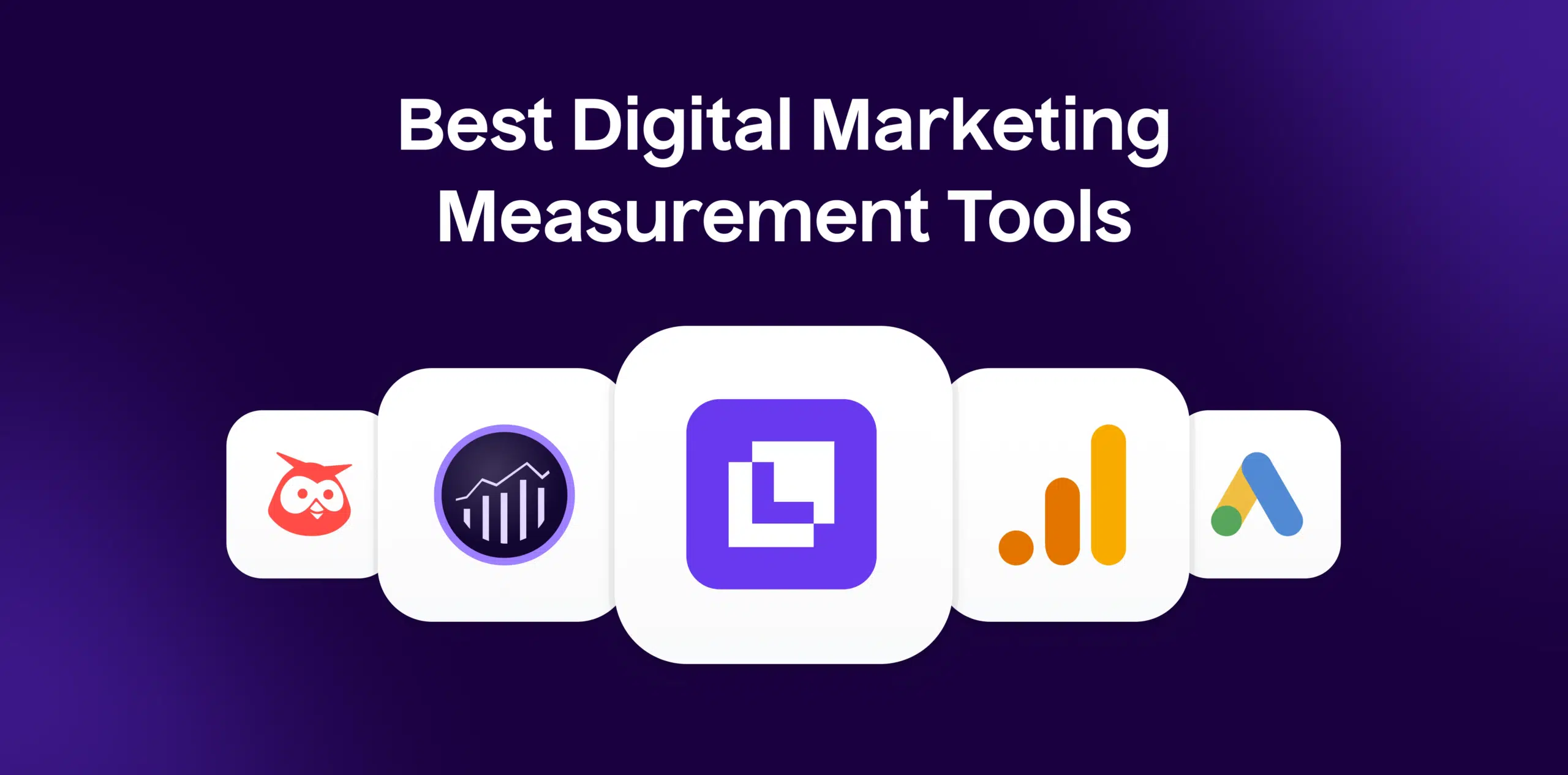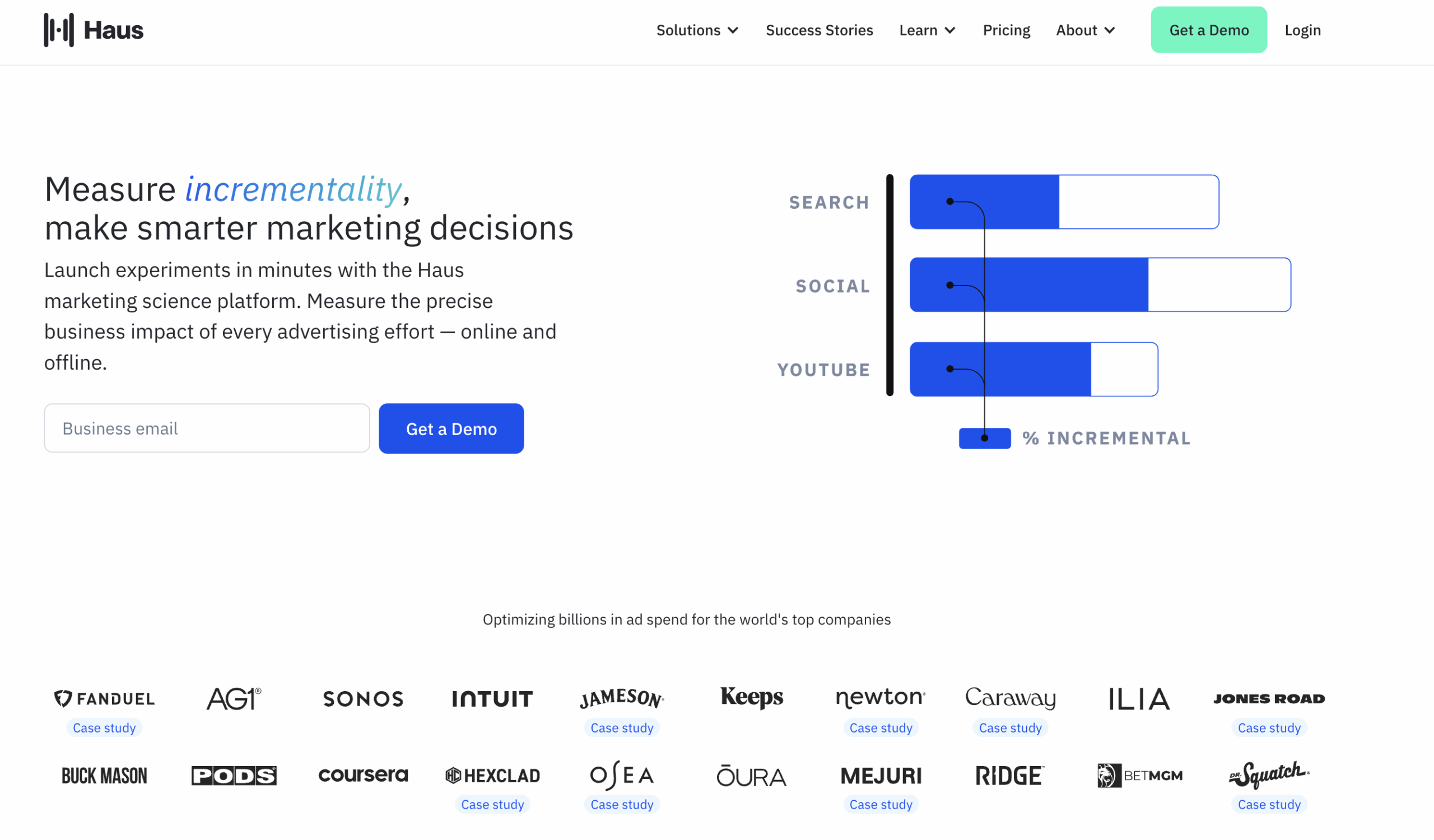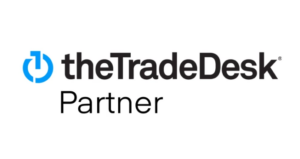Marketing success depends on knowing what truly drives performance. With campaigns running across websites, apps, social platforms, email, and offline channels, it can be difficult to separate assumptions from facts. Digital marketing measurement tools solve this challenge by tracking, analyzing, and validating the impact of every marketing activity.
These tools not only surface data on KPIs like incremental ROI (iROAS), channel-level ROI, and conversion lift but also provide actionable recommendations for budget allocation, campaign optimization, and growth planning. From general analytics platforms to platform-based dashboards and advanced unified measurement systems, businesses now have a wide range of solutions to fit their needs. The real task is choosing the right one.
What are Digital Marketing Measurement Tools?
Digital marketing measurement tools are software platforms that track and analyze the performance of digital campaigns and their attributed marketing efforts. They provide data-driven insights into key performance indicators (KPIs) such as iROAS, mROAS, iCPL, brand baseline lift, and more. These tools not only deliver data insights but also offer actionable recommendations for effective budget allocation and campaign optimization.
Read More About: Digital Marketing Measurement: A Detailed Guide for Marketers
Types of Digital Marketing Measurement Tools
There are three main types of tools used to measure digital marketing campaigns:
- General measurement tools such as Google Analytics, Adobe Analytics, Ahrefs, SEMrush, and Mixpanel.
- Platform-based analytics tools such as Hootsuite, Google Ads, Meta Analytics, Mailchimp, and Sprout Social.
- Unified marketing measurement tools such as Lifesight’s UMM, Measured, Rockerbox, Haus, LiftLab, and Recast.
Read More About: 6 Best Unified Marketing Measurement (UMM) Tools
Best General Digital Marketing Measurement Tools
1. Google Analytics
Google Analytics (GA4) is a free analytics platform that helps businesses track and understand how users interact with their websites and apps. It provides traffic insights, engagement patterns, and conversion data to guide marketing and product decisions.
Best for: Broad web/app performance tracking with strong Google stack usage.
Key features
- Event-based tracking, funnels, pathing, cohorts
- Attribution reporting and conversion modeling
- Audiences for remarketing and experimentation
- Integrations with Google Ads, BigQuery, DV360, Search Console
Advantages
- Rich free tier (for GA4 standard); strong ecosystem and docs
- Powerful segmentation and exploration workspaces
- Native ties to Google media for faster activation
Limitations
- GA4 learning curve; UI and data model differ from UA
- Sampling/thresholding in some reports (esp. on high volume)
- Google-centric; non-Google cost/effort may rise for full fidelity
2. Adobe Analytics
Adobe Analytics is an enterprise-grade digital analytics solution that offers highly customizable tracking, segmentation, and reporting. It is designed for large organizations needing granular insights into customer journeys across multiple touchpoints.
Best for: Enterprises needing granular, cross-channel analytics with governance.
Key features
- Flexible schema (eVars, props), calculated metrics, segments
- Real-time streaming and Customer Journey Analytics (CJA)
- Robust governance, role-based access, and data stitching (with AEP)
Advantages
- Very granular, enterprise-grade; strong customization and scale
- Excellent analysis workspace for advanced analysts
- Tight integration with Adobe Experience Cloud
Limitations
- Expensive and complex to implement/maintain
- Requires disciplined taxonomy and governance to shine
3. Ahrefs
Ahrefs is an all-in-one digital marketing suite covering SEO, paid search, content, and social media. It provides competitive research and campaign insights, helping teams optimize both organic and paid strategies.
Best for: SEO teams prioritizing link and content intelligence.
Key features
- Site Explorer (backlinks, keywords), Rank tracking
- Content Explorer and keyword research
- Site Audit (technical SEO)
Advantages
- Industry-leading backlink index; intuitive UI
- Great for competitive research and content planning
Limitations
- Primarily SEO (limited paid/attribution context)
- Historical cost can rise for larger teams/usage
4. SEMrush
SEMrush is an all-in-one digital marketing suite covering SEO, paid search, content, and social media. It provides competitive research and campaign insights, helping teams optimize both organic and paid strategies.
Best for: Marketing teams wanting one hub for SEO + PPC insights.
Key features
- Keyword research, rank tracking, site audits
- Competitive PPC research (ad copies, keywords)
- Content and topic tools, social scheduling add-ons
Advantages
- Broad toolkit spanning paid + organic
- Strong competitive intelligence and campaign ideation
Limitations
- Breadth over depth in some modules vs. specialist tools
- Add-ons can grow total cost
5. Mixpanel
Mixpanel is a product analytics platform focused on user behavior across digital products. It allows companies to analyze funnels, retention, and user journeys, making it especially useful for product-led growth.
Best for: Product-led growth, onboarding, retention, and feature impact.
Key features
- Event tracking with funnels, cohorts, retention
- User-level analysis and journeys; group analytics (B2B)
- A/B test evaluation and alerts
Advantages
- Great for lifecycle and feature adoption analysis
- Real-time, intuitive visualizations for PMs and marketers
Limitations
- Not a crawler/SEO tool; needs disciplined event design
- Web attribution depth is limited vs. MMPs/MMM platforms
Best Digital Platform Based Measurement Tools
1. Hootsuite
Hootsuite is a social media management platform that consolidates scheduling, publishing, and analytics across multiple social networks, enabling teams to streamline workflows and measure performance.
Best for: Social teams needing publishing + basic cross-channel reporting.
Key features
- Post scheduling, inbox, team workflows
- Channel-level analytics and reporting
- Listening/monitoring add-ons
Advantages
- Centralizes multi-network posting and reporting
- Solid governance for teams/approvals
Limitations
- Analytics depth limited by network APIs
- Paid social performance best read in native ad platforms
2. Google Ads Manager
Google Ads is Google’s advertising platform for search, display, shopping, and video campaigns. It offers built-in reporting and measurement tools to optimize ad performance in real time.
Best for: Optimizing Google media with fast feedback loops.
Key features
- Native conversion tracking, attribution, lift experiments
- Search term and audience reporting, asset-level insights
- Brand lift (YouTube), incremental tests (geo, experiments)
Advantages
- Deep, near-real-time performance visibility
- Experimentation tools and tight GA/BigQuery links
Limitations
- Platform-reported conversions may differ from independent sources
- View-through and modeled conversions require careful interpretation
3. Meta Ads Manager & Business Suite Insights
Meta Analytics provides insights for Facebook and Instagram performance through Ads Manager and Business Suite. It measures ad efficiency, creative performance, and audience behavior across Meta’s platforms.
Best for: Brands investing meaningfully in Meta who can run clean experiments.
Key features
- Event Manager (pixel/API), conversion lift tests
- Breakdown by placement, audience, creative
- Organic page/account insights in Business Suite
Advantages
- Granular creative/audience diagnostics; strong experimentation options
Limitations
- Signal loss/privacy changes require robust server-side setup
- Modeled outcomes; triangulation with external sources recommended
4. YouTube Analytics
YouTube Analytics is Google’s platform for measuring video performance on YouTube. It tracks views, watch time, retention, and engagement, helping creators and brands optimize their video strategies.
Best for: Video-led strategies and creators/brands optimizing content.
Key features
- Traffic sources, retention curves, audience demographics
- Content-type reporting (longs/shorts/live)
- Integration with Google Ads for paid lift/brand metrics
Advantages
- Deep content performance diagnostics (retention is gold)
Limitations
- Organic/video-centric; limited view of off-YouTube outcomes
5. Sprout Social
Sprout Social is a social media management and analytics tool designed for collaboration, reporting, and monitoring. It provides actionable insights into social engagement and campaign effectiveness.
Best for: Social teams needing stakeholder-ready reports and workflows.
Key features
- Publishing and engagement inbox
- Cross-network performance dashboards and tag-based reporting
- Listening/sentiment add-ons; competitor benchmarks
Advantages
- Polished reporting; collaboration features for teams
Limitations
- Cost scales with profiles/users; API limits apply
6. Mailchimp
Mailchimp is an email and marketing automation platform. It provides campaign analytics such as open rates, clicks, and conversions, and supports segmentation and automated journeys for better engagement.
Best for: SMBs and e-commerce sending frequent campaigns with simple journeys.
Key features
- Campaign performance (opens*, clicks, revenue), journeys
- A/B tests, segments, product feed integrations
- Basic attribution to revenue for e-commerce
Advantages
- Easy to launch, good templates and journey builder
Limitations
- Open rates impacted by privacy features; treat directionally
- Limited cross-channel attribution beyond email-assisted revenue
Best Unified Marketing Measurement Tools
1. Lifesight’s UMM
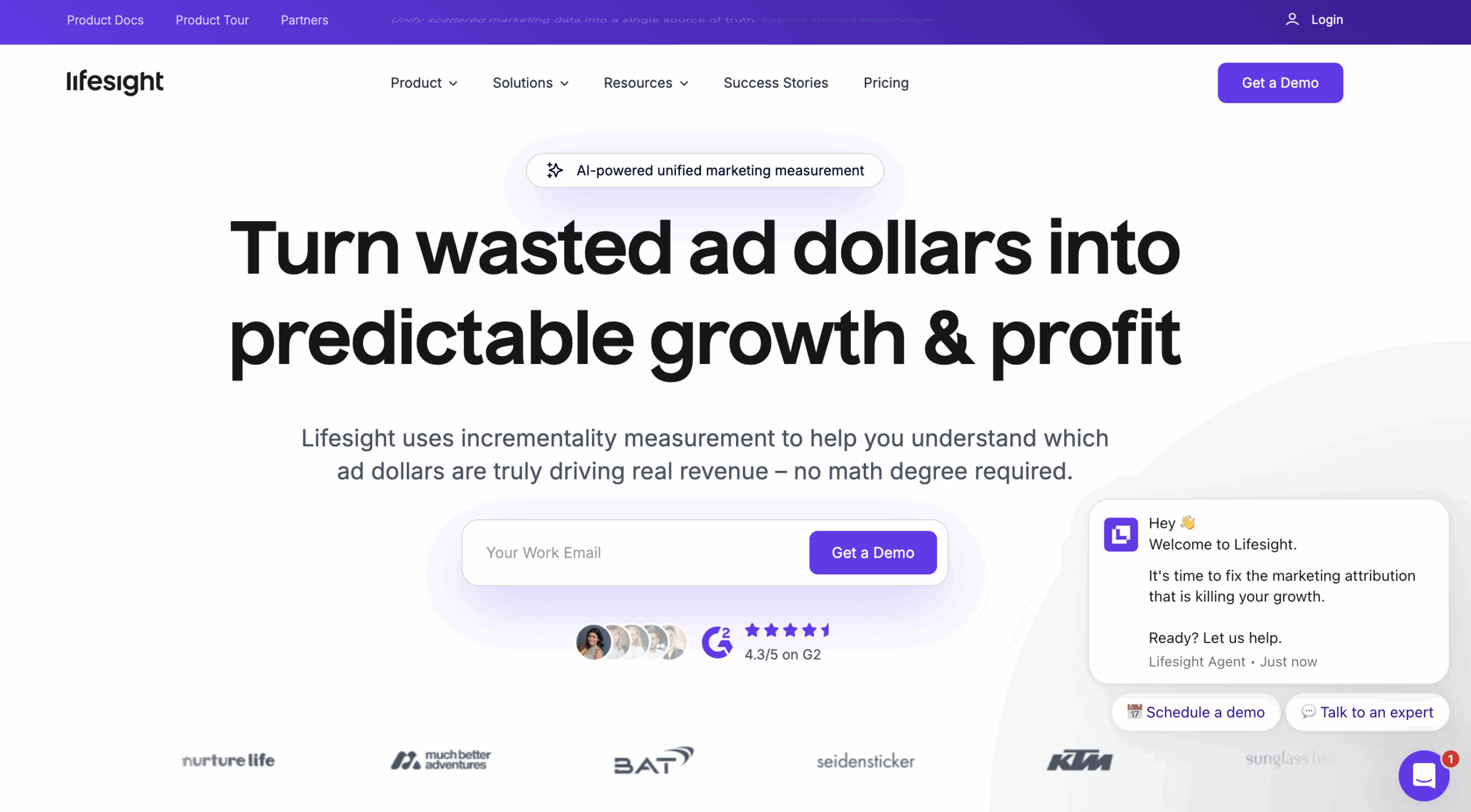
Lifesight is a unified marketing measurement platform which combines advanced marketing measurement models like marketing mix modeling, incrementality testing and causal attribution to provide a unified view of your campaign effectiveness and actionable insights to allocate the budget effectively.
Best for: Marketing teams that want a single, unified model to track all campaigns, bridging digital and offline media, and guiding budget reallocations on a weekly or bi-weekly basis.
Key features
- Full Funnel Measurement: Captures performance at every stage of the customer journey, from awareness through conversion.
- Unified Reporting: Consolidates multiple channels and data sources into a single, clear reporting framework.
- Actionable Insights: Offers data-backed recommendations for budget allocation, spend optimization, and campaign performance improvement.
- Scenario Planning & Forecasting: Enables marketers to run “what if” scenarios, predict outcomes, and plan effectively for changing market dynamics.
- Seasonality & Promotion Adaptation: Adjusts measurement models to account for seasonal trends and promotional spikes.
- New Channel Identification: Highlights under-leveraged or emerging channels that could drive incremental growth.
Advantages
- Provides one integrated solution for measuring campaigns across digital and offline media.
- Offers weekly or bi-weekly guidance for fast budget reallocation.
- Delivers scientifically robust, unbiased analytics aligned to business outcomes.
- Simplifies decision-making with clear, actionable recommendations.
Limitations
- Requires clean and reliable data feeds across all marketing channels.
- Best suited for SMBs and large enterprises with structured data systems and a focus on measurable growth.
2. Measured
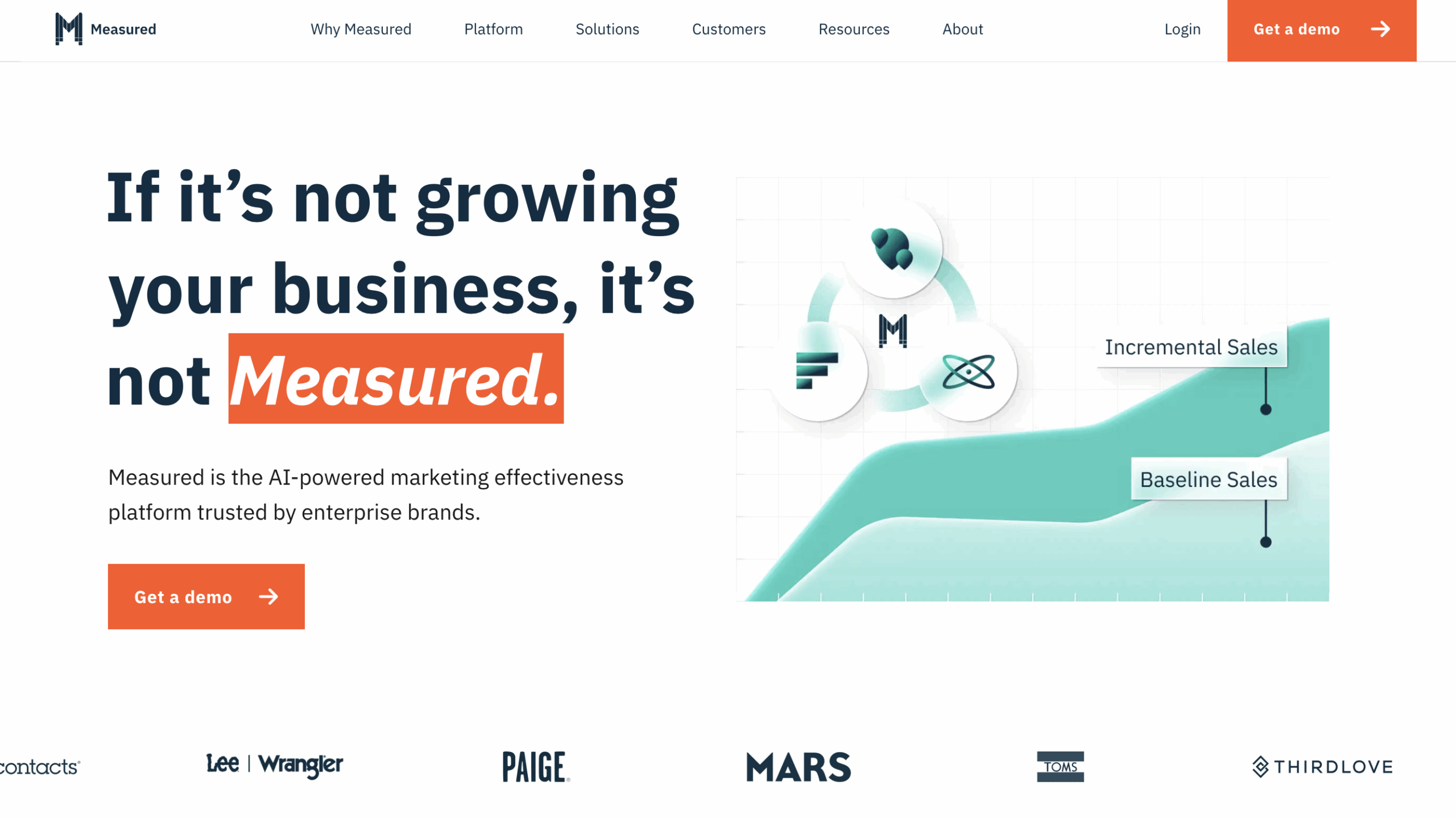
Measured is a marketing measurement platform focused on incrementality testing and media validation. It helps marketers understand the true impact of their ad spend and calibrate platform-reported metrics.
Best for: Advertisers prioritizing causal lift evidence to calibrate spend.
Key features
- Always-on geo/holdout tests and lift experiments across paid channels
- Platform comparisons (publisher vs. incrementality)
- Optional MMM for longer-term planning
Advantages
- Strong experimental rigor with clear iROAS vs. platform ROAS views
Limitations
- Experiment setups require budget and time, making results less immediate
3. Rockerbox
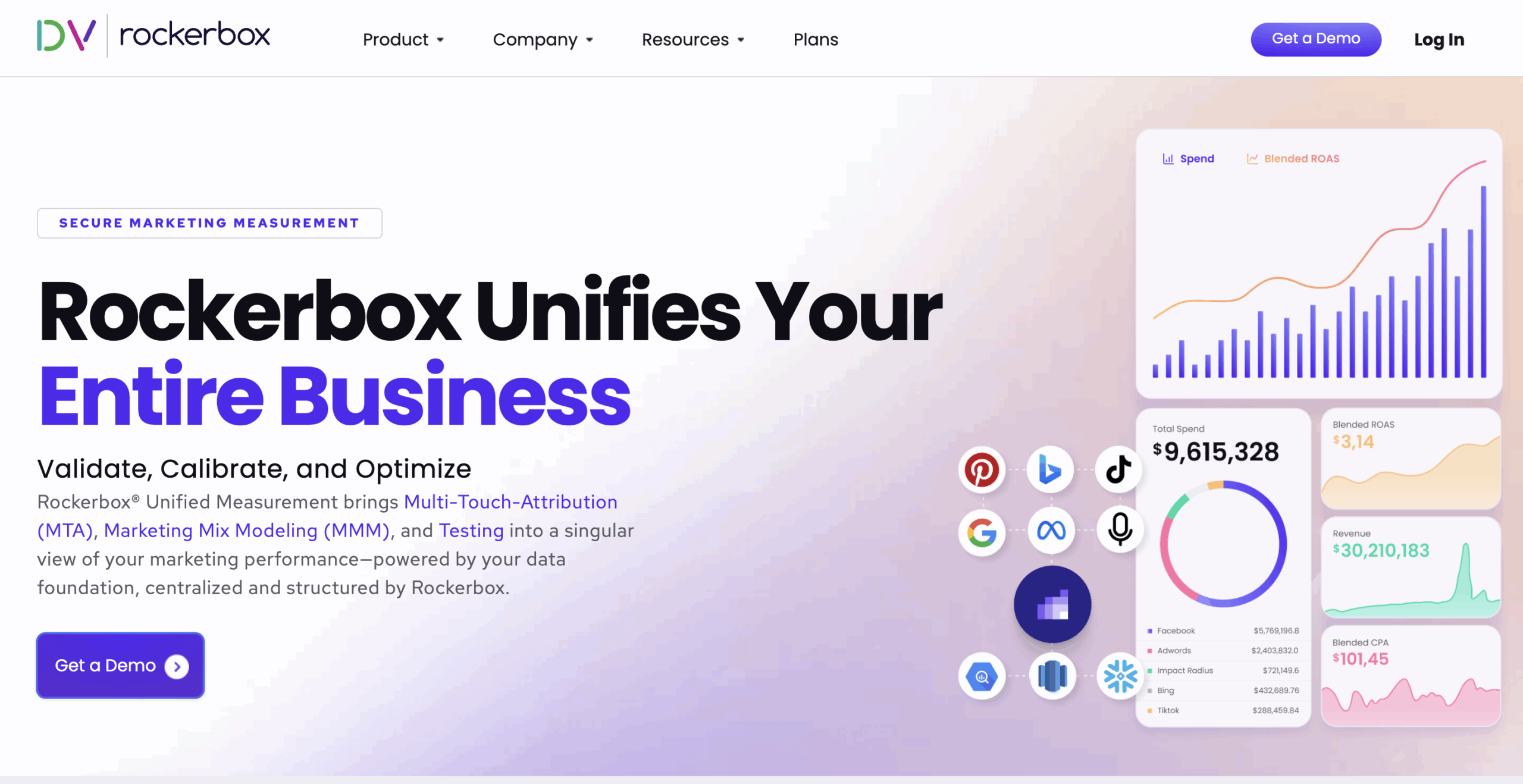
Rockerbox is a marketing measurement platform designed for DTC and e-commerce brands. It consolidates multi-channel data, attribution, and experimentation into one platform for day-to-day decision-making.
Best for: E-commerce/retail brands needing pragmatic, near-term guidance.
Key features
- Path analysis, configurable attribution rules, cohort views
- MMM and incrementality tests; LTV overlays for e-commerce
- Extensive connectors for storefronts and media
Advantages
- Quick visibility for DTC stacks; practical day-to-day decisions
Limitations
- Rule-based views can conflict with MMM; alignment work needed
4. Haus
Haus is a marketing mix modeling (MMM) platform that provides scenario planning, forecasting, and budget allocation recommendations. It helps brands simulate “what-if” scenarios for smarter spend decisions.
Best for: Teams needing quarterly/annual budget allocation and “what-if”s.
Key features
- Bayesian/time-series MMM with scenario planning
- Diminishing returns curves and budget optimizer
- Data pipelines and refresh automation
Advantages
- Clear planning workflows; makes MMM outputs decision-ready
Limitations
- Focused on MMM (experiments often complementary, not core)
5. LiftLab
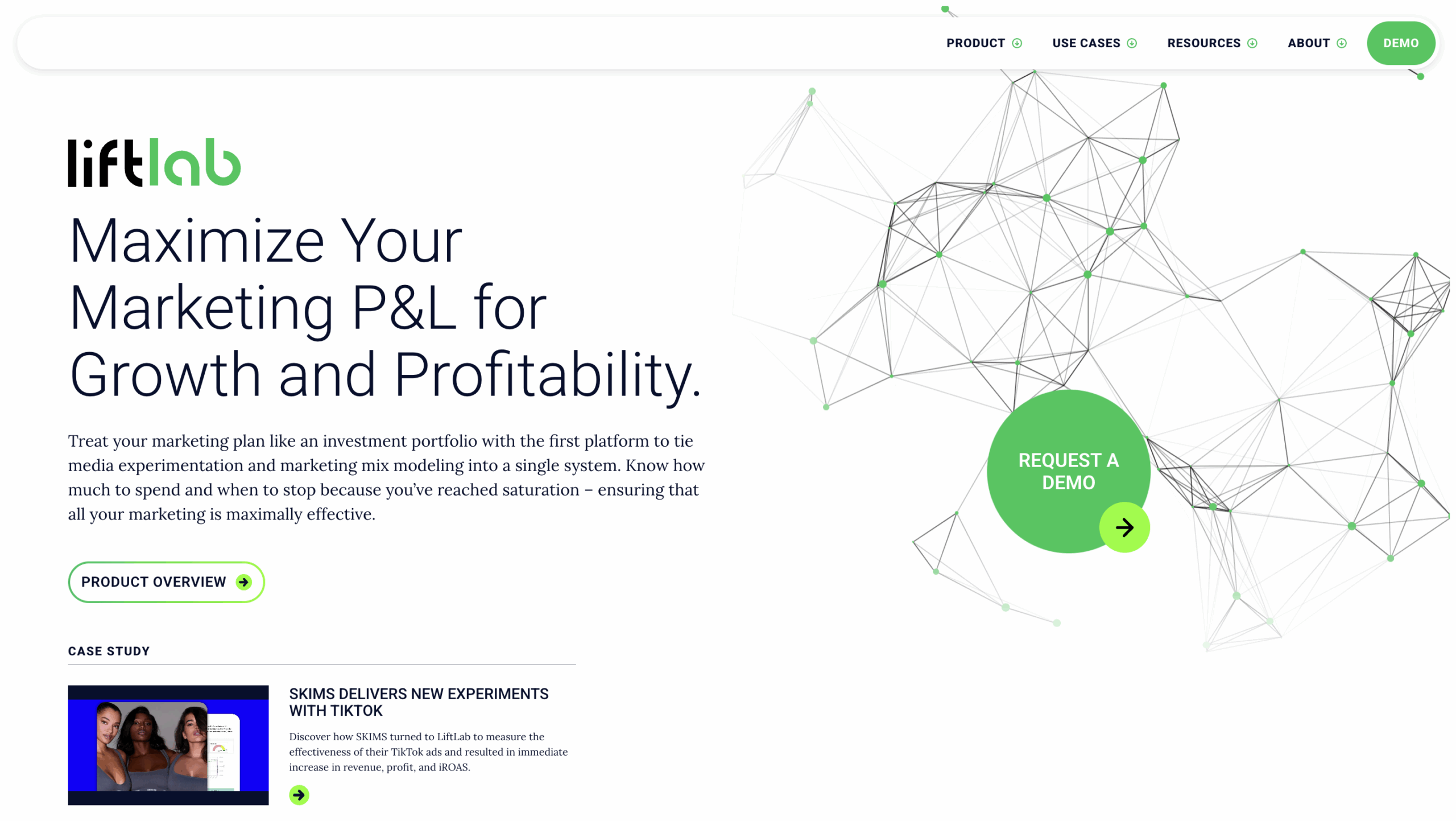
LiftLab specializes in incrementality measurement and MMM. It uses geo and audience testing to measure the true lift from advertising campaigns, enabling marketers to make more confident scaling decisions.
Best for: Brands scaling paid media who want disciplined lift programs.
Key features
- Geo-matched market tests, audience holdouts, platform validation
- Unified dashboards for lift, iROAS, and saturation
- MMM add-on for long-term mix views
Advantages
- Strong testing design support; actionable guardrails for scaling
Limitations
- Testing cadence/resources required; smaller spenders may struggle
6. Recast
Recast is a probabilistic, continuously updated marketing mix modeling platform. It provides budget recommendations, forecasts, and response curves while emphasizing transparency in uncertainty and confidence levels.
Best for: Data-savvy teams comfortable with probabilistic decision-making.
Key features
- Bayesian MMM with frequent refresh; confidence/credible intervals
- Response curves, optimal mix suggestions, forecast simulations
- Connectors for paid/owned/earned and external factors
Advantages
- Transparent uncertainty helps prevent overconfidence in point estimates
Limitations
- Requires stakeholder education on probabilistic outputs
How to Choose Best Digital Marketing Measurement Tools for My Business?
Selecting the right digital marketing measurement tool can make the difference between guesswork and growth. To choose effectively, focus on aligning the tool’s capabilities with your business challenges, KPIs, and long-term goals.
1. Define Your Challenges and Goals
Start by clarifying the core problems you want to solve. Are you struggling to unify online and offline campaign measurement, validate ad platform-reported results, forecast future outcomes, or scale spend with confidence? Clear goals make it easier to identify tools that truly address your needs.
2. Define Your KPIs
Identify the success metrics that matter most to your business. Examples include:
- Incremental ROI (iROAS)
- Channel or campaign-level ROI
- Conversion lift and attribution clarity
- Forecast accuracy and budget efficiency
- Customer lifetime value (CLTV)
Having these KPIs locked in ensures the tools you choose deliver actionable insights tied to your growth objectives.
3. Match Tools to Your Needs
3.1 Unified Insights
Choose platforms that combine Marketing Mix Modeling (MMM), incrementality testing, and attribution into one system if you want a full-funnel view and the ability to optimize both online and offline campaigns.
3.2 Causal Lift Validation
If you need evidence-based measurement, prioritize tools that specialize in geo-testing, audience holdouts, and always-on experiments. These help you calibrate platform-reported ROAS with true incremental results.
3.3 Real-Time Optimization
For brands that adjust budgets weekly or even daily, look for dashboards that refresh frequently and surface actionable insights quickly.
3.4 Scenario Planning and Forecasting
If your team manages quarterly or annual budgets, select platforms with scenario modeling, response curves, and budget optimizers to simulate “what-if” outcomes.
3.5 Scaling Media Spend
For growth-focused teams, use tools that provide guardrails through saturation insights, lift validation, and incremental ROI analysis.
3.6 Statistical Transparency
If you value rigor, consider platforms that emphasize probabilistic or Bayesian models, provide confidence intervals, and openly document their methodologies.
4 Evaluate Practical Considerations
- Ease of Integration: Does the tool connect easily with your media platforms, CRM, and data warehouses?
- Usability: Will your team be able to interpret and act on the outputs, or does it require heavy analytics expertise?
- Cost and ROI: Weigh not just licensing costs, but also the speed at which you can realize actionable insights.
- Scalability: Ensure the solution can handle larger data volumes and more channels as your business grows.
5. Test Before You Commit
The best digital marketing measurement tool is the one that directly maps to your challenges, KPIs, and decision-making cadence. Start by defining what you need, then assess which platform strengths best support your growth strategy, whether that’s unifying insights, validating incremental lift, enabling faster optimization, or planning smarter with forecasts.
Conclusion
Choosing the best digital marketing measurement tool for your business comes down to clarity and alignment. First, define your challenges and what you want to achieve. Next, set clear KPIs that reflect your success metrics. Finally, match your needs with tools that provide the right mix of insights—whether that means real-time optimization, causal lift validation, forecasting, or unified reporting across channels.
No single tool fits every business. The right choice is the one that maps directly to your goals, integrates with your data environment, and empowers your team to act on insights with confidence. By approaching the selection process systematically, you transform marketing measurement from a reporting function into a strategic growth driver.
FAQ’s
1. Why are digital marketing measurement tools important?
Digital marketing measurement tools are important, which helps marketers to eliminate guesswork by showing which campaigns actually drive results. This helps businesses allocate budgets effectively, improve campaign performance, and achieve sustainable growth.
2. Are these tools suitable for small businesses as well as enterprises?
Yes. Some tools like Google Analytics, Mixpanel, and Mailchimp work well for small businesses, while platforms like Adobe Analytics or advanced UMM solutions like Lifesight are better suited for enterprises.
3. What’s the difference between attribution and incrementality?
Attribution assigns credit to campaigns based on customer touchpoints. Incrementality measures whether a campaign truly caused additional outcomes beyond what would have happened without it. Both methods complement each other for accurate measurement.
4. How much do digital marketing measurement tools typically cost?
Costs vary widely. Some tools like Google Analytics (standard version) are free, while enterprise-grade or unified MMM platforms can range from tens of thousands to hundreds of thousands of dollars annually, depending on scale.
5. Can these tools integrate with my existing marketing platforms?
Most modern tools are designed with integrations in mind. They can connect with ad platforms, CRMs, data warehouses, and e-commerce systems to provide unified insights across channels.
6. How quickly can I see results after using these tools?
Basic analytics platforms deliver insights immediately. Advanced MMM or incrementality tools may require weeks of data collection, but once set up, they provide ongoing, actionable insights for budget optimization.
7. What features should I prioritize when evaluating tools?
Key features to look for include:
- Data integration capabilities
- Incrementality or lift measurement
- Scenario planning and forecasting
- Real-time dashboards and reporting
- Scalability to grow with your business
Essential resources for your success
